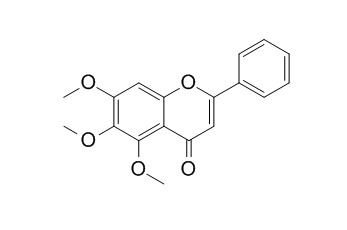5,6,7-Trimethoxyflavone
5,6,7-Trimethoxyflavone exhibits relatively high inhibitory effects on herpes simplex virus type 1 (HSV-1), human cytomegalovirus and poliovirus, it and acylovir were synergic in their anti-HSV activities at levels below the 50% inhibitory concentrations for antiviral activity.
5,6,7-Trimethoxyflavone down-regulates the expressions of the pro-inflammatory iNOS, COX-2, TNF-α, IL-1β, and IL-6 genes in macrophages by interfering with the activation of NF-κB, AP-1, and STAT1/3.
Inquire / Order:
manager@chemfaces.com
Technical Inquiries:
service@chemfaces.com
Tel:
+86-27-84237783
Fax:
+86-27-84254680
Address:
1 Building, No. 83, CheCheng Rd., Wuhan Economic and Technological Development Zone, Wuhan, Hubei 430056, PRC
Providing storage is as stated on the product vial and the vial is kept tightly sealed, the product can be stored for up to
24 months(2-8C).
Wherever possible, you should prepare and use solutions on the same day. However, if you need to make up stock solutions in advance, we recommend that you store the solution as aliquots in tightly sealed vials at -20C. Generally, these will be useable for up to two weeks. Before use, and prior to opening the vial we recommend that you allow your product to equilibrate to room temperature for at least 1 hour.
Need more advice on solubility, usage and handling? Please email to: service@chemfaces.com
The packaging of the product may have turned upside down during transportation, resulting in the natural compounds adhering to the neck or cap of the vial. take the vial out of its packaging and gently shake to let the compounds fall to the bottom of the vial. for liquid products, centrifuge at 200-500 RPM to gather the liquid at the bottom of the vial. try to avoid loss or contamination during handling.
Phytomedicine.2024, 122:155065.
J Pharm Biomed Anal.2024, 251:116444.
Food Chem.2024, 446:138870.
Food Analytical Methods2017, 10:3225-3234
Molecules.2019, 24(22):E4022
Anticancer Res.2021, 41(3):1357-1364.
Front Pharmacol.2021, 12:770667.
Pharmaceuticals (Basel).2022, 15(8):982.
Sci Rep.2023, 13(1):13072.
J Sep Sci.2019, 42(21):3352-3362
Related and Featured Products
Journal of Antimicrobial Chemotherapy,1997,39(6):821–824.
Antiviral activity of 5,6,7-trimethoxyflavone and its potentiation of the antiherpes activity of acyclovir.[Reference:
WebLink]
METHODS AND RESULTS:
A naturally occurring flavone, 5,6,7-Trimethoxyflavone (TMF), isolated from the plant Callicarpa japonica, was subjected to antiviral assays. The compound exhibited relatively high inhibitory effects on herpes simplex virus type 1 (HSV-1), human cytomegalovirus and poliovirus. The anti-HSV-1 action was not due to the inhibition of virus adsorption, entry and viral protein synthesis, but might involve, at least in part, a virucidal activity, which results in a suppression of viral binding to host cells at an early replication stage.
CONCLUSIONS:
TMF and acylovir were synergic in their anti-HSV activities at levels below the 50% inhibitory concentrations for antiviral activity.
Food & Chemical Toxicology, 2013, 62:847-855.
5,6,7-trimethoxyflavone suppresses pro-inflammatory mediators in lipopolysaccharide-induced RAW 264.7 macrophages and protects mice from lethal endotoxin shock.[Reference:
WebLink]
5,6,7-Trimethoxyflavone (TMF), methylations of the hydroxyl groups of oroxylin A or baicalein, was found to significantly inhibit the productions of nitric oxide (NO) and prostaglandin E2 (PGE2) in lipopolysaccharide (LPS)-treated RAW 264.7 macrophages. However, no report has been issued on the anti-inflammatory potential of TMF and the underlying molecular mechanism.
METHODS AND RESULTS:
In the present study, we investigated the anti-inflammatory effects of TMF in LPS-induced RAW 264.7 macrophages and LPS-induced septic shock in mice. TMF dose-dependently inhibits iNOS and COX-2 at the protein, mRNA, and promoter binding levels and that these inhibitions cause attendant decreases in the productions of NO and PGE2. TMF inhibits the productions and mRNA expressions of tumor necrosis factor-α (TNF-α), interleukin (IL)-1β, and IL-6 induced by LPS. Furthermore, TMF suppress the transcriptional activity of nuclear factor-kappa B (NF-κB) and activator protein-1 (AP-1), and nuclear translocations of NF-κB, AP-1, and signal transducer and activator of transcription 1/3 (STAT1/3). Pretreatment with TMF increase the survival rate of mice with LPS-induced endotoxemia and reduced the serum levels of cytokines.
CONCLUSIONS:
Taken together, these findings suggest that TMF down-regulates the expressions of the pro-inflammatory iNOS, COX-2, TNF-α, IL-1β, and IL-6 genes in macrophages by interfering with the activation of NF-κB, AP-1, and STAT1/3.



